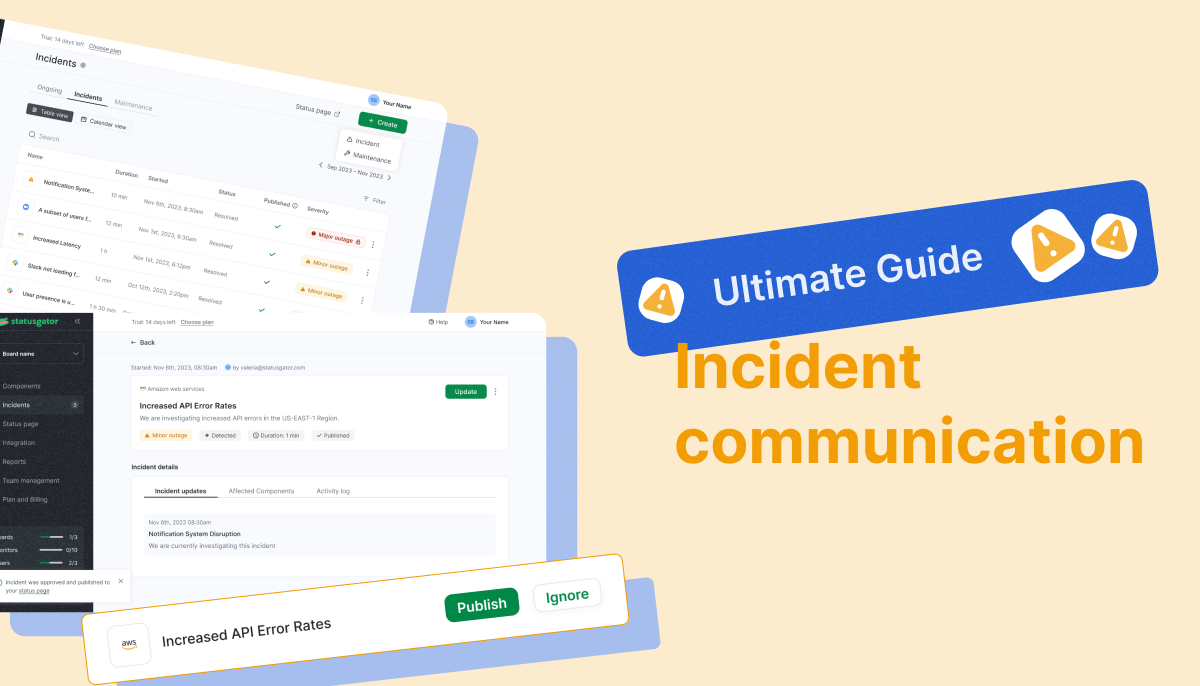
In the digital realm, incidents such as service disruptions and security breaches are inevitable. Incidents affect your customers and stakeholders. Also, incidents pose significant challenges to IT, Ops, DevOps, and customer support teams. As we increasingly depend on digital tools and services, the demand for seamless performance escalates, highlighting the importance of effective incident communication.
This guide dives into the proper notification of users about service issues, internal communication for teams, and maintaining trust and satisfaction. By splitting incident communication into stages, we aim to equip IT tech teams with the knowledge to navigate disruptions confidently.
Discover how to enhance communication with users and responder preparedness to safeguard your service’s integrity.
What is Incident Communication?
Incident communication is about informing users clearly, promptly, and empathetically about service outages or performance issues, aiming to reduce the impact on their experience. It involves IT, Ops, DevOps, and customer support teams to keep users well-informed during disruptions.
This guide will show you how to create an incident communication plan that tackles technical problems and enhances user relationships through transparency and empathy. You’ll learn effective strategies for managing web-scale communication challenges and maintaining the resilience of your digital services.
Additionally, the guide highlights the importance of a status page, drawing on our experience monitoring over 3,600 SaaS companies as a central tool in incident communication.
Following this guide, you can develop incident action planning and strategic communication to reference during any service outage, turning challenges into opportunities to strengthen user trust.

Timing and Criteria for Effective Incident Communication
Understanding when to initiate incident communication is crucial for maintaining trust and transparency with your users. The trigger for incident communication is, obviously, an incident. However, recognizing what constitutes an incident is key to timely and effective messaging.
An incident is characterized by any event that negatively impacts the quality of your service, leads to data loss, or compromises security. For instance, imagine receiving a notification that your personal information might be at risk following a security breach at an online retailer where you’ve shopped. Or, consider the times you’ve been on a website and received a message explaining delays or performance issues due to unexpectedly high traffic. These scenarios exemplify incidents that necessitate prompt critical incident communication with affected users.
The spectrum of incidents can vary widely, from minor inconveniences like slower website response times during peak traffic periods to significant security incidents that jeopardize sensitive user data.
Regardless of the scale, it is essential to acknowledge the issue and keep your users informed about what happened, what measures are being taken to resolve it, and how future occurrences will be mitigated. This approach not only helps in managing the immediate fallout of the outage but also plays a vital role in preserving user loyalty and the overall integrity of your service.
It’s important to note that incidents refer to events that have already begun affecting service quality or security, not potential future issues. However, if your team identifies a vulnerability or a looming problem that could escalate into an incident, addressing it proactively is also wise.
In such situations, preemptive action is necessary, though user communication might not be unless the emerging issue begins to affect your service. This distinction ensures that your outage communication efforts are focused and effective, fostering an environment of openness and reliability around your digital offerings.
Establishing a Clear Incident Definition Framework
To effectively manage and communicate incidents, it’s crucial to define what qualifies as an incident first. Many organizations in the digital sphere adopt a tiered severity level system to classify incidents. This approach offers a structured way to evaluate the impact and urgency of incidents.
Setting precise thresholds for each severity level is fundamental. For example, a “SEV 1” (severity 1 level) incident should have clear, identifiable criteria so that all team members understand its significance without ambiguity. This clarity is crucial for ensuring a unified and effective response to incidents.
A tiered severity system facilitates a structured approach to incident management and helps to navigate the complexities associated with varying degrees of service disruptions.
By distinguishing between different levels of severity, teams can prioritize their responses and allocate resources more efficiently.
Regardless of the specific criteria you establish for each severity level, adopting a stringent communication policy for the most critical incidents, particularly those involving security breaches or data loss, is advisable.
This zero-tolerance stance towards communication ensures that all stakeholders are promptly informed, reinforcing the importance of transparency and swift action in maintaining trust and integrity in your services.
Identifying the Stakeholders in Incident Communication
When unplanned incidents occur, the impact goes beyond just the immediate technical issues—it affects everyone connected to your service. This group includes your customers, who depend on your service to work smoothly, and your internal teams, whose morale is crucial for your operations.
Even a minor incident can be a direct path to a tarnished reputation, diminished customer loyalty, and potentially, a hit to your financial performance – especially if you do not communicate it properly.
Customers, shaken by a negative experience, may start considering alternatives after spotting a pattern of unreliability. The fallout from such events doesn’t stop at customer churn; it also encompasses the potential loss of prospective users deterred by trust issues and stress on the team, which can lead to decreased productivity.
However, incidents also present an opportunity to build trust through clear and proactive communication. Informing customers about what happened, what’s being done to fix it, and how future problems will be prevented can lessen their frustration.
By setting the right expectations and showing a commitment to fixing and improving, you do more than just limit the immediate effects – you also build a foundation for stronger, trust-based relationships with both your customers and your team.
Streamlining Incident Communication: A Strategic Guide
Effective incident communication is essential for maintaining user trust and ensuring the credibility of your service. Promptly addressing incidents demonstrates accountability and commitment to service quality, reinforcing user confidence in your brand.
Here’s a plan on how to refine your approach for maximum impact:
1. Anticipate and Prepare for the Unplanned Incidents
- Incident Forecasting
Begin by cataloging potential issues specific to your service. Understanding these scenarios prepares you for swift action.
- Preparation Tools
Develop templates, updates, and runbooks tailored to each potential incident. This preparation ensures quick and accurate first contact with users during crises.
2. Define Responders, Team Roles and Responsibilities
A team with defined roles enhances efficiency in incident identification, communication, and resolution. Training each member responding to an incident in their role ensures smooth operation. Critical roles for large companies include major incident manager, communication specialists, and customer support.
For smaller teams, it’s the tech team and help desk. In any case, a status page helps the incident response team and other parties such as DevOps, or competitive intelligence teams with the response process.
3. Establish Incident Communication Channels
- Internal and External Channels
Delineate channels for internal alerts and user communication, starting with private or public status pages. This clarity ensures that your team and your users are promptly informed.
Do not assume that everyone in the company is paying as close attention to the incident as you and the IT team are. It’s really essential to boil down all the technobabble that’s going on during an incident discussion into the bare facts for other teams, like on-call customer support.
- Popular Channels
Consider email alerts, social media, and dedicated status pages for external communication. Tools like Slack are effective for internal alerts.
Establishing your communication channels and messaging strategies well in advance is essential for effective incident management. Professional support teams and site reliability engineers prioritize planning to ensure that, when an incident occurs, the response is swift and coordinated.
4. Key Incident Communication Channels
Dedicated Status Page:
- A centralized source of updates during incidents.
- Offers subscription options for instant updates.
- It is recommended as the primary communication channel.
Embedded Status Widget:
- Integrates status information directly on your website or product.
- Ensures immediate visibility for site visitors.
Email:
- Enables subscription for updates.
- Utilizes either direct sending or status page-triggered sends.
- Provides a reliable method for detailed communication.
Workplace Chat Tools:
- Facilitates seamless internal communication.
- Integrates with platforms like Slack or Microsoft Teams for efficient problem resolution.
Social Media:
- Useful for broad reach and real-time updates.
- Should complement, not replace, other communication methods.
SMS (optional):
- Delivers immediate, attention-grabbing alerts.
- Best used sparingly to avoid message fatigue.
5. Utilize Pre-Written Incident Communication Templates
Efficiency in critical outages includes having go-to templates that enable quick initial first contact and updates throughout the duration of service interruption, reducing response times.
While templates provide a foundation, always personalize messages with current details of unplanned downtime and timelines to meet user expectations.
6. Effective Incident Communication Strategy
- Preparation
Decide on your communication channels in advance, ensuring a ready-to-implement plan when incidents occur.
- Centralization
Use a dedicated status page for comprehensive updates, allowing users to find all necessary information in one place.
- Integration
Embed status widgets on your main website to alert visitors of ongoing incidents without needing to search for a status page.
- Diversification
Employ a mix of email, chat tools, social media, and SMS to cover various user preferences and ensure widespread message dissemination.
- Coordination
Align messages across channels to direct users back to the status page for detailed incident information, maintaining clarity and consistency.
7. Execute Prompt and Clear Incident Communication
- Initial Alert
Inform users immediately upon incident detection. Delay or silence can erode trust.
- Ongoing Updates
Regular progress reports keep users informed and engaged, minimizing frustration.
- Resolution Notification
After resolving the incident, explain the cause, resolution, and any necessary user actions.
- Post-Incident Analysis
Conduct thorough reviews and share findings when appropriate, highlighting lessons learned and future preventative measures.
Summary
Incidents are inevitable, but their impact can be minimized with strategic preparation. You can navigate incidents effectively by organizing your team, preparing response tools, and committing to transparent communication.
Enhance your incident communication strategy with tools like StatusGator which are designed to support you in building trust and reliability with your users. Explore these strategies further by signing up for a free trial and taking the first step towards a more resilient service today.

FAQ on Incident Communication
Q: What is an incident response communication plan?
A: An incident response communication plan is a company-specific guide laying out a plan for how your organization will communicate to your stakeholders (internal and external) in the event of an IT incident or cyber attack. Typically, this looks like a predefined set of steps that alleviate the fallout from such incidents as effectively as possible. StatusGator offers a guide that helps IT service providers and SaaS companies prepare an incident communication plan and tailor it to any specific needs.
Q: Why is communication important in a major incident?
A: Incident communication is important to keep service users and stakeholders aware of the disruptions. Miscommunication can affect user trust and the company’s revenue, and negatively affect employees.
When an incident occurs, the first people to know about it are your stakeholders. Whether it’s your customers at the end of the process flow or your internal stakeholders depending on your services, a major incident will affect them first.
Your organization’s primary concern should be the impact it has on all the affected parties, but communication can alleviate the effects significantly. Keeping everyone in the loop during an incident with timely updates goes a long way.
Q: How do you communicate with customers during an outage sample?
A: A sample of how you communicate with customers during an outage is primarily a status page. Notifications via SMS or email, or channels such as Slack, are common methods for communicating incidents. However, to get the most detailed, timely responses, many companies utilize a status page to communicate incidents.
If you’re interested in a modern, efficient status page to communicate incidents to your stakeholders, try StatusGator today.
Q: What do you say to customers when systems are down?
A: When your systems are down, communicating with customers is easier if you have a precise response plan. The status page helps with automating outage communication. Your message to customers should announce the disruption, include apologies for the inconvenience, and state the approximate duration of the incident or the next update. You do not have to provide all the details, but it makes sense to give some details for transparency. Post-incident communication should also be a part of what you say to customers when systems are down, focusing on your actions to prevent future occurrences.
Q: How do you communicate with system outages?
A: Communicating during system outages occurs on a status page with automation behind the incident communication process. Other channels include notifications via SMS or email or channels such as Slack. However, to get the most detailed, timely responses, many companies utilize a status page to communicate outages.
If you want a modern, efficient status page to alert users of outages to your users and stakeholders, try StatusGator today.
Q: How do you communicate during a blackout?
A: During a blackout, it can be difficult to communicate through notifications, but this doesn’t have to be the case. A status page on a separate domain could communicate an outage for you during the blackout.
Q: What are the 4 stages of an incident?
A: The 4 stages of an incident typically refer to the steps, stages, or phases of incident management. Dealing with an incident can be broken into 4 stages:
- Detection: This is the stage where an incident is first detected, perhaps through monitoring systems or user reports. At this stage, detecting the incident and its potential severity is key. Once an incident is detected, it needs to be communicated to the relevant stakeholders. This is where incident communication best practices come in – and having a predefined incident communication plan goes a long way.
- Response: This involves taking actions to alleviate the fallout from the incident, contain its impact, and restore normal operations as quickly as possible. The response may include tasks such as troubleshooting the root cause analysis, and ensuring you get back on track as timely as possible.
- Resolution: The final stage is resolution, where the incident is fully resolved, and normal operations are restored. Make sure to communicate to your users the incident is resolved, and take a look at some analytics from the incident, either in an investigation format or auditing process to prevent the incident from happening again.
- Post-Event Activities: The final stage of incident management, learning and improving, is crucial yet frequently overlooked. In this phase, the incident and response efforts are reviewed to prevent recurrence and enhance future response strategies.
Q: What are the 5 stages of the incident management process?
A: IT incident management can generally be broken down into 5 stages:
- Logging: Formal recording of incident details as soon as possible.
- Categorization: Sorting incidents by type and urgency in order to prioritize certain areas to resolve before others.
- Diagnosis: Establish the issue/issues via root cause analysis.
- Escalation: Investigating root causes and escalating if needed.
- Resolution and Closure: Fixing the issue and formally closing the incident – updating your stakeholders as you go.



